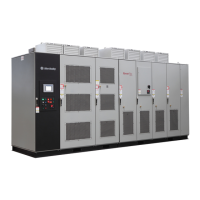Rockwell Automation Publication 6000-IN006F-EN-P - March 2018 39
Drive Electrical Interconnection Chapter 3
Figure 26 - Isolation Transformer Primary and Secondary Winding Orientation
The secondary windings are brought out to corresponding vertical isolated stand-
offs on the body of the transformer (orientated U, V, and W from left to right as
viewed from the front). See Figure 27
.
Each secondary winding set will have a designated U, V, and W terminal
connection. For example, (from top to bottom and left to right) the terminals
from the first winding set are 1W, 1V, and 1U, the terminals from the next
winding set are 2W, 2V, and 2U, and so on.
As shown in Figure 25
, the first winding set (1U, 1V, and 1W) will connect to the
three-phase input power connection of the first power module in the U motor
phase array (PCA1), the second winding set will connect to the second power
module in the U motor phase array (PCA2), and the third winding set will
connect to the third power module in the U motor phase array (PCA3). The
next three winding sets connect to the power modules in the V motor phase array.
The remaining three winding sets connect to the power modules in the W motor
phase array.
Figure 25
shows 3.0/3.3 kV configuration. The 6.0/6.6 kV and 10 kV
configuration have more power modules and therefore have more corresponding
isolation transformer secondary windings. The concept is the same—the top
third of the winding sets feeds the power modules in the U phase, the middle
third feeds the power modules in the V phase, and the bottom third feeds the
power modules in the W phase.
PRIMARY WINDING INPUT
SECONDARY WINDING OUTPUT
A (L1) B (L2) C (L3)
U
V
W
SECONDARY WINDING OUTPUT
U
V
W

